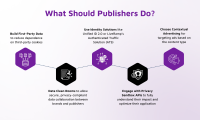Programmatic Redefined: No More ‘One-Size-Fits-All’ Approach
Before the mainstream adoption of programmatic technology, advertising deals were a haphazard affair. The ad buying and selling process relied heavily on manual negotiations, which were indeed tedious, costly, time-consuming, and lacked the targeting precision we have today. Until the underlying technologies such as supply-side platforms (SSPs) and demand-side platforms (DSPs) were introduced to bring ease and efficiency to the ad tech ecosystem. However, they overlook some crucial aspects and limitations of programmatic advertising.
Programmatic advertising, while powerful, is not a one-size-fits-all solution. Today’s customer landscape is incredibly diverse with varying demographics, interests, and behaviors. Each segment requires a tailored approach that goes beyond generic solutions.
The uniformity of programmatic can be overcome in the following ways:
- Eliminate native constraints
In the current ad tech landscape, glocalization plays a pivotal role in shaping an effective programmatic advertising strategy. Marketers must adopt a nuanced regional approach to achieve success. However, programmatic advertising often encounters limitations due to rigid algorithms and predefined parameters. To overcome this constraint, it is imperative to introduce greater flexibility into the system.
This empowers advertisers to customize their campaigns and strategies according to their unique objectives, target audiences, and industry verticals. In addition, by harnessing emerging technologies like artificial intelligence and machine learning, advertisers can enhance data quality and glean valuable insights.
- Customer-first approach
There is a growing recognition within the ad tech ecosystem that the primary focus needs to shift from a technology-first approach to a customer-first approach. While technology plays a crucial role in enabling effective advertising solutions, the ultimate goal should be to prioritize the needs, preferences, and experiences of publishers and advertisers.
The current state of the ad tech ecosystem may not fully meet the needs and expectations of the stakeholders. There is a scope for advancements that better align with their interests, such as improved targeting capabilities, more accurate measurement and attribution, enhanced transparency and control, streamlined workflows, and solutions that provide better ROI (return on investment) and effectiveness.
- Rethink the supply chain
Rethinking the supply chain components in programmatic advertising enables them to be treated as distinct entities, paving the way for novel opportunities in differentiation and value creation. This revamped perspective on the supply chain also strengthens the alignment between publishers and advertisers.
Publishers can monetize their inventory more effectively, while advertisers can integrate various technologies and platforms that align with their specific needs for media planning, dynamic bidding, audience ingestion, targeting, bidder management, outcomes delivery, and inventory curation.
Treating each component as an entity allows advertisers to define and customize strategies unique to their campaign goals. For example, in media planning, advertisers can determine the most effective channels and placements for their target audience. In audience targeting, they can create specific segments or personas to focus on. This level of customization helps in delivering tailored and impactful ad campaigns.
- Need for a capability mindset
By shifting from a business model mindset to a capability mindset in the programmatic advertising ecosystem, a wider array of use cases can be employed to achieve particular objectives. It encompasses the various ways in which programmatic advertising strategies and technologies can be utilized to address specific marketing goals and target specific audiences.
For example, native advertising involves creating ads that seamlessly blend with the look, feel, and context of the surrounding content. This approach aims to provide more organic and non-disruptive advertising to strike the balance between ads and user experience. However, negotiating specific placements and content integration for native advertising often requires direct discussions with publishers.
By adopting a capabilities mindset in programmatic advertising, advertisers can enhance their ability to navigate such negotiations and ensure the desired level of brand alignment.
- Integration of third-party technology
The impending elimination of third-party cookies and the future of a cookieless world are enormous wins in terms of privacy protection. However, it is a privilege enjoyed only by big giants or walled gardens such as The New York Times and poses a limitation for targeting capabilities for smaller marketers. There is a need for seamless third-party technology integration into programmatic platforms to access first-party data.
With this integration into the ad tech stack, buyers can access and utilize first-party data in a privacy-compliant manner. They provide the tools and infrastructure needed to leverage first-party data for audience targeting, campaign optimization, and personalization, without solely relying on cookies or other traditional identifiers.
- Maximum monetization
Publishers often prioritize content creation, audience engagement, and content distribution and promotion through SEO strategies, rather than magnifying their focus on the supply chain components. However, to remain competitive in the rapidly evolving digital ecosystem and to take their website monetization to the next level, publishers should shift their attention toward their supply chains and carefully consider the various components involved in delivering advertisements on their platforms.
For instance, publishers focused on maximizing revenue through premium ad placements and direct deals may prioritize integrating with demand-side platforms (DSPs) that offer access to high-quality advertisers and premium ad inventory. This setup allows them to have more control over the types of ads displayed on their platform and negotiate specific deals with advertisers.
In essence, thinking about the supply chain is about being strategic and deliberate in the choices publishers make regarding the technology and partnerships they rely on to monetize their content through advertising.
- Commerce and Retail Media
The existing framework and systems designed for programmatic advertising do not adequately address the unique requirements of commerce and retail media. The programmatic constructs focus on automating the ad buying and selling process, optimizing reach and efficiency, and leveraging data for targeting. While they are effective for general advertising purposes, they may not fulfill the specific needs and complexities of this industry.
The unique nature of the retail industry demands an optimized approach that includes features and capabilities such as integration with e-commerce platforms, advanced targeting to utilize first-party data to its fullest potential, and localized advertising.
The shift from the ‘one-size-fits-all’ approach in programmatic advertising involves three key aspects: customization, closer examination of ad tech platforms, and flexibility throughout the advertising and customer acquisition process. By harnessing the potential of AI and ML technologies, programmatic advertising can become dynamic and adaptable, enabling advertisers and publishers to craft personalized, targeted, and effective campaigns that cater to diverse industries, verticals, and marketing objectives.




Leave a Reply